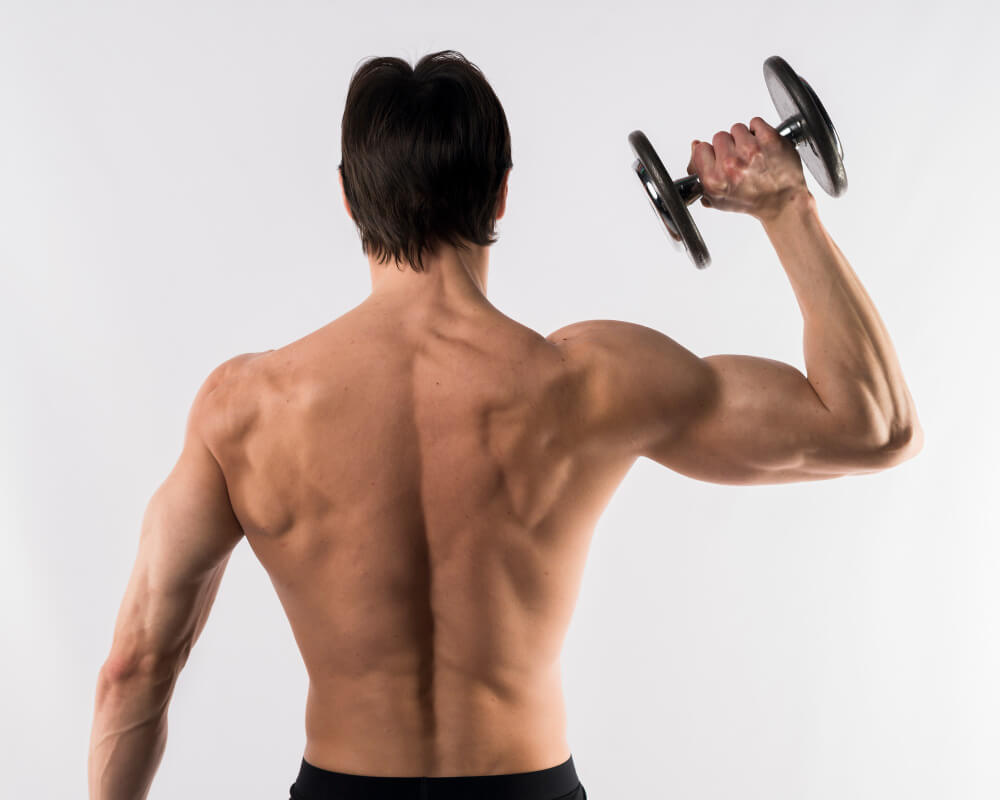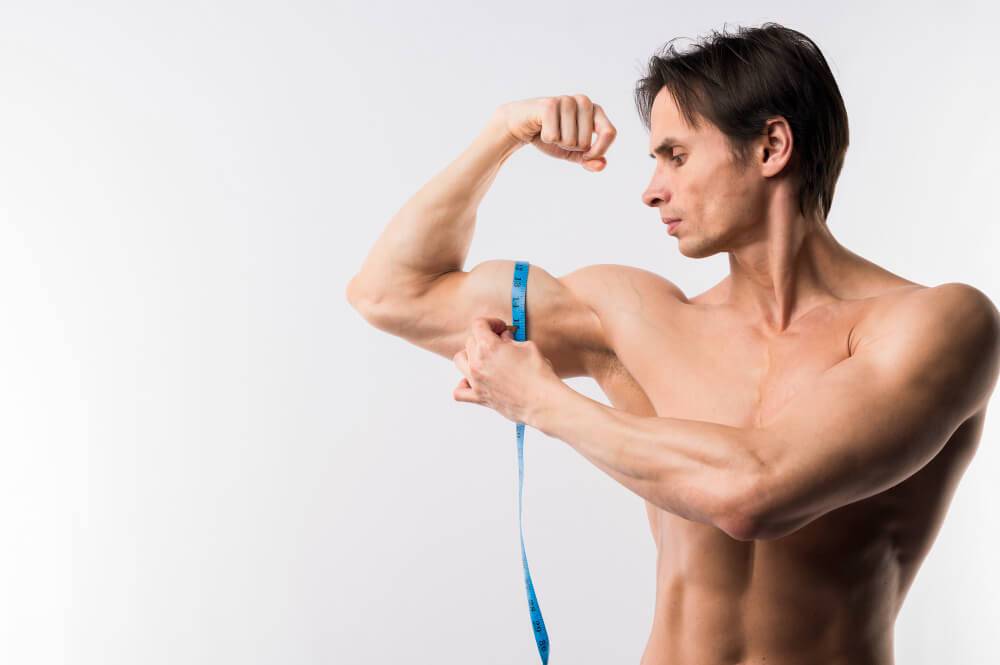Are you looking to improve your shoulder training? Cable machines provide a varied and effective means to build shoulder strength and size.
This blog will guide you through the top 10 cable machine shoulder exercises to help you achieve faster gains.
Whether you’re a fitness enthusiast, bodybuilder, or regular gym-goer, these exercises will enhance your workout routine and deliver impressive results.
Cable Machine Shoulder Exercises
Cable shoulder exercises have grown in popularity because of their ability to maintain sustained tension throughout the movement.
This constant tension helps in effective muscle activation, leading to better muscle growth and endurance. Proper form and technique are crucial in cable exercises to prevent injuries and maximize benefits.
Let’s explore the world of cable shoulder exercises and see how they can transform your upper body training.
Shoulders Anatomy

To get the most out of your shoulder workouts, it’s essential to understand the muscle groups involved. The shoulder comprises three main muscle groups:
- Anterior Deltoid (front)
- Lateral Deltoid (side)
- Posterior Deltoid (rear)
Anterior Deltoid
The anterior deltoid, located at the front of your shoulder, is primarily responsible for shoulder flexion and inward rotation.
It plays a crucial role in movements where the arm is raised in front of the body, such as front raises or pushing exercises like the bench press.
Lateral Deltoid
The lateral deltoid, also known as the side deltoid, is situated on the outer part of your shoulder. Its primary function is shoulder abduction, which involves extending the arm away from the body to the side.
Exercises like lateral raises and overhead presses effectively target this muscle, contributing to broader shoulders and improved upper body aesthetics.
Posterior Deltoid
The posterior deltoid, or rear deltoid, is located at the back of the shoulder. This muscle group is involved in shoulder extension and external rotation, playing a vital role in pulling movements and posture stabilization.
Cable exercises can effectively target these muscles, promoting balanced growth and lowering the risk of imbalances that could lead to injury.
Equipment Needed
The primary equipment required for these exercises is the cable machine. It consists of adjustable pulleys that allow you to perform a variety of movements.
Ensure the machine is in good condition and secure to avoid accidents.
Safety considerations include checking the weight stack, cables, and handles before starting your workout.
Warm-Up
Warming up is crucial to prepare your shoulders for intense exercise. A proper warm-up increases blood flow, enhances flexibility, and reduces the risk of injury.
Recommended warm-up exercises include arm circles, shoulder shrugs, and light resistance band exercises. Spend at least 10 minutes warming up to ensure your shoulders are ready for action.
Start with light weights and progressively increase the intensity as you progress.
Top 10 Cable Shoulder Exercises
Avoid hunching your back.Here is the list of top 10 cable shoulder exercises for massive shoulder gains:
Cable Front Raise
The Cable Front Raise isolates and strengthens the anterior deltoids (front). By using the cable machine, you maintain constant tension on the front of your shoulders throughout the entire range of motion.
This helps to enhance muscle activation, leading to more effective hypertrophy and endurance.
How to :
- Setup: Stand in front of the cable machine with your feet shoulder-width apart. Attach a straight bar or a handle to the low pulley.
- Grip: Grip the bar or handle with both hands using overhand grip, palms facing down.
- Position: Keep your arms straight but not locked at the elbows, and allow the bar or handle to rest against your thighs.
- Lift: Exhale and raise the bar or handle directly in front of you until your arms are parallel to the floor. Keep your core tight and avoid shaking your body.
- Hold: Pause briefly at the top of the movement to maximize muscle contraction in the anterior deltoids.
- Lower: Inhale and while keeping control, gradually lower the bar or handle back to the beginning position.
Remember to start with lightweight using the right form, then gradually increasing the resistance as you get more comfortable with the exercise.
Tips:
- Avoid swinging your body.
- Focus on controlled movements.
Cable Lateral Raise
This exercise targets the lateral head (side) of the shoulder. By performing lateral raises with cables, you benefit from continuous tension throughout the lift, which leads to enhanced muscle activation and growth.
This exercise is beneficial for improving shoulder symmetry and overall upper body aesthetics.
How to:
- Setup: With the pulley in the lowest position, stand up next to the cable machine.
- Grip: Attach a single handle to the pulley and hold it with one hand. Stand with your feet shoulder-width apart.
- Starting Position: Keep your arm straight and your hand resting against your outer thigh.
- Raise: Exhale and lift the handle to the side while keeping your elbow slightly bent.
- Height: Raise your arm until it is parallel to the floor. Your palm should be facing down.
- Hold: Pause briefly at the top of the movement to enhance muscle contraction.
- Lower: Inhale and slowly lower the handle back to the starting position in a controlled manner.
By adhering to proper form and focusing on controlled movements, you will maximize the effectiveness of the Cable Lateral Raise, improving shoulder strength and aesthetics.
Tips:
- Keep your core engaged.
- Perform the movement slowly for maximum tension.
Related Articles: Try This! 8 Effective Cable Machine Arm Workout for Bigger Arms
Shoulder Press
A classic move to build overall shoulder strength. This exercise targets the entire deltoid muscle group, with a particular emphasis on the anterior and lateral deltoids.
Utilizing the cable machine for this movement ensures continuous tension, which aids in muscle activation and growth more effectively than free weights.
How to:
- Setup: Adjust the cable machine’s pulley to shoulder height and attach a straight bar or handle. Stand with your feet shoulder-width apart and your back straight.
- Grip: Grab the bar or handles with both hands using an overhand grip and bring them up to shoulder level, palms facing forward.
- Position: Keep your elbows bent over 90 degrees and align your shoulders, ensuring your core is engaged.
- Press: Exhale and press the bar or handles upward, fully extending your arms overhead without locking your elbows.
- Hold: Pause briefly at the top of the movement to maximize muscle contraction in your shoulders.
- Lower: Inhale and slowly bring the bar or handles back down to shoulder level in a controlled manner, maintaining tension in your muscles.
- Repeat: Perform desired number of reps, keeping proper form and control throughout the exercise.
Tips:
- Don’t lock your elbows at the top.
- Keep your movements controlled and steady.
Face Cable Pull
This exercise targets rear deltoids and upper back. It is crucial for improving shoulder stability and posture reducing the risk of shoulder injury.
Adding face pulls into your routine helps with the development of the front and side delts, promoting overall shoulder health and functional strength.
How to :
- Setup: Adjust the cable machine’s pulley to the upper-chest level and attach a rope handle.
- Grip: Grab each side of the rope with an overhand grip, palms facing downward.
- Position: Stand with your feet shoulder-width apart, step back slowly to create tension on the cable, and keep your arms fully extended in front of you.
- Pull: Exhale and pull the rope directly towards your face, flaring your elbows out to the sides and keeping them level with your shoulders.
- Squeeze: At the end of your movement, squeeze your shoulder blades and hold for a brief second to maximize muscle activation in your rear deltoids and upper back.
- Return: Inhale and slowly return your arms to the starting position, maintaining control to keep tension on the muscles.
Tips:
- Keep your back straight.
- Focus on squeezing your shoulder blades together.
Cable Reverse Fly
The Cable Reverse Fly isolates the posterior deltoids (rear), which often receive less attention in shoulder workouts. This exercise helps in achieving balanced shoulder development.
By doing this exercise, you enhance the strength and stability of your upper back and rear shoulders, contributing to better overall shoulder health and functionality.
How to :
- Setup: Set the cable machine pulleys at shoulder height and attach single handles to both sides.
- Position: With your feet shoulder-width apart, take a stand between the pulleys, grasp the handles with an overhand grip, and stretch your arms.
- Stance: Keep your back straight and slightly bend your knees, engaging your core for stability.
- Pull: Exhale and pull the handles out to your sides in a wide arc, keeping a slight bend in your elbows.
- Squeeze: At peak of the movement, squeeze your shoulder blades together and pause briefly to maximize muscle activation in your upper back and rear deltoids.
- Lower: Inhale and slowly bring the handles back to the starting position in a controlled manner, maintaining tension in your muscles.
- Repeat: Continue for desired number of reps, ensuring that your movements are smooth and controlled throughout the set.
Tips:
- Maintain a slight bend in your elbows.
- Avoid using momentum to pull the cables.
Single-Arm Lateral Raise
The Single-Arm Lateral Raise is great for targeting the lateral deltoid, which helps in building shoulder width and enhancing upper body aesthetics.
By focusing on one arm at a time, it allows for isolated muscle activation and addressing any strength imbalances between sides.
How to:
- Setup: Attach a single handle to a low pulley on the cable machine.
- Position: Stand side-on to the machine, grabbing the handle with the hand farthest from the pulley, and keep your feet shoulder-width apart.
- Stance: Engage your core, keep your back straight, and let your arm hang down close to your body.
- Lift: Breathe out, then slowly extend your arm out until it reaches shoulder height while maintaining a small bend in your elbow.
- Hold: Pause briefly at the top of the movement to maximize muscle contraction in the lateral deltoid.
- Lower: Inhale and gently lower your arm back to the starting position in a controlled manner.
- Repeat: Perform the desired number of repetitions, then switch to the opposite side and repeat the exercise with the other arm.
Tips:
- Use a slow and controlled motion.
- Keep your torso stationary.
High-to-Low Crossover
A compound move targeting the upper chest and front shoulders.
This exercise also helps improve stability and strength in the shoulder and chest region, making it a valuable addition to any upper-body workout routine.
How to :
- Setup: Attach handles to the high pulleys and stand in the center.
- Position: Step forward slightly to place tension on the cables and stand with your feet shoulder-width apart.
- Grip: Grab the handles with an over-hand grip, arms extended out to the sides slightly above shoulder height.
- Pull: Exhale and bring the handles down and across your body towards your hips, forming an “X” shape in front of you.
- Squeeze: At the bottom of the movement, squeeze your chest and front shoulders together and hold for a brief second.
- Return: Inhale and slowly return the handles to the starting position, keeping control to maintain tension on the muscles.
- Repeat: Perform desired number of reps, ensuring smooth and controlled movements throughout the set.
Tips:
- Keep a slight bend in your elbows.
- Focus on consistent tension.
Related Articles: 8 Best Arm Workouts With Barbell for Definition – Try Now!
Cable Upright Row
The Cable Upright Row targets traps and shoulder muscles.
This movement ensures continuous tension that maximizes shoulder and upper back muscle engagement. It’s particularly effective for enhancing shoulder size, strength, and stability.
How to:
- Setup: Attach straight bar to a low pulley on the machine.
- Position: Stand facing towards the machine with your feet shoulder-width apart. Grab the bar with an over-hand grip, hands wider than shoulder width.
- Stance: Maintain a straight back, engage your core, and keep your chest up.
- Lift: Exhale, then lift the bar towards the chin leading with elbows and keeping the bar tight to your body.
- Squeeze: At the top of the movement, squeeze your traps and shoulder muscles, pausing briefly.
- Lower: Inhale and slowly lower the bar back to the starting position in a controlled manner.
- Repeat: Perform desired number of reps, ensuring smooth and controlled movements throughout the set.
Tips:
- Keep your elbows higher than your wrists.
- Avoid shrugging your shoulders.
Cable Shrugs
Great for trap activation. Cable Shrugs is an excellent exercise for targeting the upper trapezius (upper traps) muscles, which play a crucial role in shoulder stability and posture.
By consistently doing Cable Shrugs into your workout routine, you can enhance the strength and thickness of your traps, improve shoulder alignment, and reduce the risk of neck and shoulder injuries.
How to:
- Setup: Attach straight bar to a low pulley on the machine.
- Position: Stand facing the machine, grab the bar with an over-hand grip, keeping your hands about shoulder width apart.
- Stance: Keep your back straight, chest up, and core engaged.
- Lift: Exhale and raise your shoulders towards your ears, and squeeze your traps at the top of the movement.
- Hold: Pause briefly to maximize muscle contraction in your traps.
- Lower: Inhale and slowly lower your shoulders back to the starting position in a controlled manner.
- Repeat: Perform desired number of reps, maintaining smooth and controlled movements throughout the set.
Tips:
- Focus on lifting with your traps, not your arms.
- Hold the top position for a second.
Rear Deltoid Fly
The Cable Rear Deltoid Fly targets the rear shoulders, contributing to balanced shoulder development and improved posture.
This exercise promotes shoulder stability, reducing the risk of injuries and enhancing overall upper-body strength and functionality.
How to:
- Setup: Attach D-handles to the cables on a multi-functional machine and stand facing the machine with the pulleys at shoulder height.
- Position: Grab the handles with an over-hand grip, arms outstretched, and a slight bend in the elbows.
- Stance: Keep your feet shoulder-width apart, your torso steady, and your core engaged.
- Pull: Exhale and pull the handles outwards in a reverse fly motion, keeping your arms slightly bent.
- Squeeze: At the end of the motion, squeeze the shoulder blades together and hold for a brief second.
- Lower: Taking a breath, carefully bring the handles back to the beginning while keeping your balance.
- Repeat: Perform desired number of reps, ensuring each rep is done with smooth and controlled movements.
Tips:
- Focus on a smooth, controlled motion.
- Avoid hunching your back.
Sample Shoulder Workout Plan

This sample workout plan incorporates a variety of cable exercises to target different muscle groups in the upper body. Ensure proper warm-up before beginning and cool down to finish.
Warm-Up (10 minutes)
- Arm circles: 2 sets of 20 reps (10 forward, 10 backward)
- Shoulder shrugs: 2 sets of 15 reps
- Cross-body arm swings: 2 sets of 20 reps
Workout Routine
1. Single Arm Lateral Raise: 3 sets of 12 reps per side
- Focus on slow and controlled lifts to target the deltoids effectively.
2. High-to-Low Crossover: 3 sets of 15 reps
- Ensure a full range motion to engage the upper chest and front shoulders.
3. Cable Upright Row: 3 sets every 12 reps
- Maintain proper form and avoid shrugging your shoulders to target traps and shoulders.
4. Cable Shrugs: 3 sets of 15 reps
- Emphasize on squeezing the traps at the top of the movement for maximum activation.
5. Rear Deltoid Fly: 3 sets of 12 reps
- Aim for controlled movements and squeeze the shoulder blades together to engage the rear deltoid.
Cool Down (5–10 minutes)
- Overhead shoulder stretch: Hold for 30 seconds per side
- Cross-body shoulder stretch: Hold for 30 seconds per side
- Chest stretch: Hold for 30 seconds
Notes
- Rest for 60–90 seconds between sets.
- Modify weights and repetitions based on your fitness level.
- Focus on maintaining proper form with each exercise to prevent injury.
This balanced upper body cable workout plan aims to strengthen and stabilize the entire shoulder region, enhancing performance and physique.
Benefits of Cable Shoulder Exercises

Cable exercises offer unique benefits compared to free weights. They provide constant tension, which enhances muscle activation and growth.
Additionally, cables allow for smoother and more controlled movements, reduce the risk of injury, and promote symmetry between muscle groups.
Benefits :
- Enhanced Muscle Activation: Cables provide constant tension throughout the movement, leading to greater muscle activation and growth.
- Improved Control and Stability: The guided motion of cable systems ensures smoother and more controlled movements, reducing the risk of injury.
- Versatility and Range of Motion: Cable machines allow for a wide variety of exercises and angles, targeting different parts of the shoulder and upper body.
- Balanced Muscle Development: Cables help promote muscular symmetry by allowing unilateral exercises, ensuring even strength and development on both sides of the body.
- Functional Strength: Cable exercises mimic natural movement patterns, enhancing functional strength and carrying over into daily activities and sports performance.
Note: Want to know about more exercises… Visit here, they have covered 16 different exercises.
Common Mistakes to Avoid
When performing shoulder exercises using cables, it’s essential to maintain a proper form for maximum effectiveness and to prevent injury. Here are some common mistakes to avoid:
- Using Excessive Weight: Beginning with large weights might result in bad form and even injury. Begin with manageable weights and progressively increase as you become stronger.
- Incorrect Body Positioning: Ensure your back is straight, chest up, and core engaged to avoid unnecessary strain on your spine and other muscles.
- Fast, Jerky Movements: Perform exercises with slow, controlled movements to maximize muscle engagement and reduce the risk of injury.
- Neglecting Warm-Ups and Cool-Downs: Skipping these essential steps can lead to muscle strain and inhibit recovery. Always include a proper warm-up and a cool-down routine.
- Inadequate Rest Between Sets: Not allowing sufficient rest can lead to fatigue and impact your performance. Take 60–90 seconds of rest between sets for optimal recovery and muscle performance.
Tips for Increasing Effectiveness
- Focus on slow, controlled movements to increase the benefits of your exercises.
- Engage your core, maintain proper form, and gradually increase weights as you become more comfortable with the exercises.
- Consistency and attention to detail will yield the best results.
Cool-Down and Stretching
Cooling down is just as important as warming up. It helps with muscle recovery and reducing soreness.
Effective stretches include arm swings, shoulder rolls, and static stretches targeting the shoulders.
Spend at least 10 minutes cooling down to aid recovery.
Nutrition Tips for Shoulder Muscle Growth

Proper nutrition supports muscle growth and recovery. Ensure adequate protein intake to repair muscle fibers and stay hydrated to maintain performance.
Maintaining a balanced diet with healthy fats, carbs, and vitamins will enhance your muscle-building efforts.
Injury Prevention and Safety Tips
Preventing injuries is crucial for long-term progress. Always do a proper warm up before workouts and cool down afterward.
Listen to body and avoid pushing through pain. Consult with a fitness professional if confused about form or technique.
Conclusion
Incorporating cable shoulder exercises into your routine can elevate your shoulder training and accelerate your gains. The exercises offers unique benefits and can be tailored to suit all fitness levels. You can find more useful articles on our Article page.
Remember proper form, stay consistent, and most importantly, enjoy the process. Ready to transform your shoulder workouts? Integrate these exercises into your regimen and witness the difference.
FAQs (Frequently Asked Questions)

1. What are the best cable exercises for shoulder growth?
Cable exercises such as the Cable Lateral Raise, Cable Front Raise, Cable Rear Delt Fly, and Cable Shoulder Press promote shoulder growth and strength.
2. How often should I perform cable shoulder exercises?
For optimal results, it is recommended that shoulder exercises be included in your workout plan 2-3 time per week, allowing adequate rest and recovery between sessions.
3. Can cable exercises replace free weights for building shoulder muscles?
While cable exercises offer unique benefits like constant tension and better control, they should complement, rather than replace, free weights. A balanced approach incorporating both can yield the best results.
4. What is the advantage of using cable machines over dumbbells for shoulder exercises?
Cable machines provide continuous tension and allow for more controlled movements, enhancing muscle activation and reducing the risk of injury, leading to balanced and effective shoulder development.
5. How can I prevent shoulder injuries when using cable machines?
To prevent injuries, ensure that you do a proper warm up, maintain correct form, use manageable weights, avoid jerky movements, and include a thorough cool-down and stretching session after your workout.








